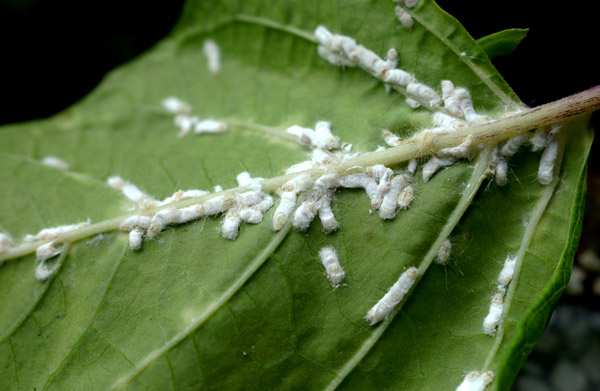
Avocado Mealybug
Nipaecoccus Nipae
Pathogène :
Insect
Type:
Risque:
HIGH
Cochinillas



¿QUIÉN LO CAUSA?
Nipaecoccus nipae, commonly known as the avocado mealybug, is a hemipteran insect belonging to the Pseudococcidae family. This insect is oval in shape and is covered in a white waxy coating that gives it a cottony appearance. The females are sessile and adhere to the plant, while the males are winged and are responsible for reproduction. Females lay eggs in cottony masses that protect the young until they hatch. The nymphs go through several stages before becoming adults, during which they feed on the sap of the host plant. Nipaecoccus nipae feeding causes weakening of the plant, and in severe infestations, can lead to the death of branches or even the entire plant. The reproductive cycle is rapid under favorable conditions, allowing for multiple generations per year.
SÍNTOMAS
The avocado mealybug, caused by Nipaecoccus nipae, mainly affects the foliage and fruits of the avocado. By feeding on the sap of the plant, the mealybug introduces toxins that interfere with the growth and development of the tree. Additionally, honeydew production by mealybugs encourages the growth of sooty fungi that can cover leaves and fruits, affecting photosynthesis and fruit quality.
- Presence of white cottony masses on leaves, branches and fruits
- Yellowing and premature leaf fall
- Deformation and fall of fruits
- Necrotic Taches on leaves and fruits
- Coverage of honeydew and sooty fungus growth on affected parts
- Reduction in tree vigor and productivity
TEMPERATURA Y HUMEDAD
20-30°C
50-70%
VÍAS DE TRANSMISIÓN
Wind, Contaminated tools, Infested plants, Soil movements, Insect vectors
Do you want to remove this pest? Choose how you want to treat it.
TRATAMIENTOS
Tratamientos químicos
• RAPE OIL 1.53% [AL] P/V
• RAPE OIL 848.24 g/l [EC] P/V
• ORANGE OIL 60g/L [ME] P/S
• PARAFFIN OIL (CAS [64742-46-7]) 79% [EC] P/V
• PARAFFIN OIL (CAS [64742-46-7]) 80% [EC] P/V
• PARAFFIN OIL (CAS [8042-47-5]) 54.6% [EW] P/V
• PARAFFIN OIL (CAS [8042-47-5]) 79% [EC] P/V
• PARAFFIN OIL (CAS [97862-82-3]) 40% [EW] P/V
• PARAFFIN OIL (CAS [97862-82-3]) 80% [EC] P/V
• Paraffin oil 65.4% [EW] P/V
• PARAFFIN OIL 81.7% [EC] P/V
• PARAFFIN OIL 83% [EC] P/V
• ACETAMIPRID 20% [SG] P/P
• AZADIRACTIN 1% (AS AZADIRACTIN A) [EC] P/V
• Azadirachtin 2.6% (AS AZADIRACTIN A) [EC] P/V
• DELTAMETHRIN 2.5% [EC] P/V
• MALTODEXTRIN 47.6% [SL] P/V
• PYRIPROXIFEN 10% [EC] P/V
• Planococcus citri (Pheromone)
• POTASSIUM SALTS OF FATTY ACIDS C14-C20 48% [EW] P/V
• TAU-FLUVALINATE 24% [EW] P/V
Tratamientos permitidos en agricultura ecológica
• RAPE OIL 1.53% [AL] P/V
• RAPE OIL 848.24 g/l [EC] P/V
• ORANGE OIL 60g/L [ME] P/S
• PARAFFIN OIL (CAS [64742-46-7]) 79% [EC] P/V
• PARAFFIN OIL (CAS [64742-46-7]) 80% [EC] P/V
• PARAFFIN OIL (CAS [8042-47-5]) 54.6% [EW] P/V
• PARAFFIN OIL (CAS [8042-47-5]) 79% [EC] P/V
• PARAFFIN OIL (CAS [97862-82-3]) 40% [EW] P/V
• PARAFFIN OIL (CAS [97862-82-3]) 80% [EC] P/V
• Paraffin oil 65.4% [EW] P/V
• PARAFFIN OIL 81.7% [EC] P/V
• PARAFFIN OIL 83% [EC] P/V
• AZADIRACTIN 1% (AS AZADIRACTIN A) [EC] P/V
• Azadirachtin 2.6% (AS AZADIRACTIN A) [EC] P/V
• MALTODEXTRIN 47.6% [SL] P/V
• Planococcus citri (Pheromone)
• POTASSIUM SALTS OF FATTY ACIDS C14-C20 48% [EW] P/V
Tratamientos biológicos
• CRYPTOLAEMUS MONTROUZIERI
Recomendaciones
- Regularly monitor trees for early signs of infestation.
- Introduce and encourage natural enemies, such as parasitoids and mealybug predators.
- Apply horticultural oils and insecticidal soaps to reduce mealybug populations.
- Maintain good health of the garden, eliminating plant debris and controlling weeds that may serve as shelter.
- Avoid excess nitrogen fertilization, which can favor the proliferation of mealybugs.
- Prune infested branches and destroy them to reduce the source of infestation.
- Use sticky traps to capture males and reduce reproduction.
TRATAMIENTOS
Remèdes maison
There are no home treatments
Alliés naturels
Traitements chimiques
There are no treatments for this disease. Treatments are directed at the insect vectors that transmit it. See insect treatments.
RECOMMANDATIONS
- Check the back of the leaves frequently, especially in dry weather.
- Spray water on the leaves to increase humidity and prevent them from settling.
- Keep plants healthy with good watering and adequate light.
- If you see cobwebs or damage, clean the leaves with a damp cloth or pressurized water.
- Use potassium soap or neem oil every few days until they disappear.
Plantes répulsives
Rosemary, Dill, Coriander
PRODUITS RECOMMANDÉS
*Los tratamientos recomendados no dejan de ser recomendaciones según las bases de datos de las autoridades y en ningún momento sustituyen las directrices marcadas según la legislación de cada país
*Les produits présentés sont des recommandations et ne sont pas nos propres produits. En tant qu'associés Amazon, nous gagnons des revenus grâce aux achats de produits recommandés.





















